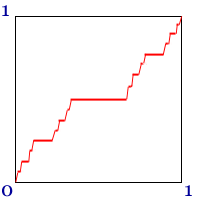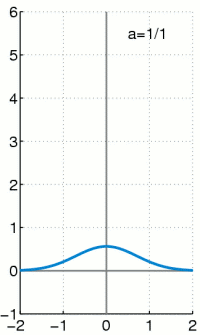20 August 2014
Joint lunchbreak with T in the freezing August sun. We sat on the steps of the Warwick Manufacturing Group eating our packed lunches and discussing Sard’s theorem (analysis) which says that for any properly smooth function on the Real line, the set of critical values (on the graph, those are the points at which the line is flat, parallel to the x-axis) has a measure zero (or something to that effect). That means that – although the number of critical values may easily be countably infinite, and even uncountably infinite – it is essentially zero when compared to the whole of the line. Apparently, once you have too many critical values – imagine driving along a road and stopping everywhere – then the graph of the function is no longer smooth because it becomes broken down into too many infinitesimal segments. I imagine the line becoming very wiggly on a tiny scale – something like the 1.5-dimensional lines of fractals, though I’m not sure this is correct. A better example is the Devil’s Staircase which is very much non-smooth (so nothing prevents it, in theory, to have a large number of critical values).

Figure 1 The Devil’s staircase (Source: https://www.math.hmc.edu/funfacts/figures/30003.3.1.gif)
Sard’s theorem brought us to the question whether a flat function with one insanely tall and thin spike in the middle can be called a smooth function… and apparently it can’t, and is instead called a distribution. (http://en.wikipedia.org/wiki/Dirac_delta_function ) The cool thing about the distribution (aka Dirac delta function) is that it is essentially a function over functions, that is, it’s a function-like thing into which you can feed other functions and get results; it is hugely useful in physics. The annoying detail is that, while you can add distributions together, multiply a distribution with a number or even differentiate it, you can’t multiply it by other distributions (or by itself). So δ^δ or other useful operations such as powers or exponentiation make no sense.

“Dirac function approximation” by Oleg Alexandrov – self-made with MATLAB. Licensed under Public domain via Wikimedia Commons – http://commons.wikimedia.org/wiki/File:Dirac_function_approximation.gif#mediaviewer/File:Dirac_function_approximation.gif
This then brought me to an attempt to grasp the meaning of Martin Hairer’s contribution which brought him (and the Warwick Maths department) one of this year’s four Fields Medals. However, I won’t be summarising it here… I am far from being able to understand the essence of his 180-page manuscript which “must have been downloaded into his brain by a more intelligent alien race” (www.simonsfoundation.org/quanta/20140812-in-mathematical-noise-one-who-heard-music ) and lays out a neat theory of hitherto unknown regularity structures underpinning the previously unruly stochastic partial differential equations… In my defence, a friend who is a lecturer in computer science, said that of course he himself could’t understand the actual contribution either.
While T was drawing the naughty spiky delta nought function on the blackboard, Ian Stewart wandered past, unpacking some mail and recycling the package. I’ve learnt not to be star-struck when sitting around in the Warwick Maths department, mainly thanks to the fact that everyone is very friendly, but still, you don’t get Ian Stewarts wandering past you all the time (you do, if you work at Warwick Maths :p). In the book exchange box under the staircase in the middle of the Common Room, there is a German translation of Ian Stewart’s “Equations that changed the world”. I briefly considered nicking it and then got distracted by hugs at the blackboard (which, as I learnt yesterday from Christopher Zeeman’s essay http://www2.warwick.ac.uk/fac/sci/maths/general/institute/histories-small.pdf , are actually greenglass).